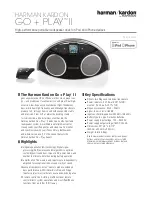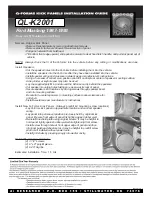
14
most likely to suffer from the response irregularities introduced by the room
itself, operating as they do below approximately 80 Hz in most systems.
Recent research into the behavior of rooms as a function of speaker placement
has concluded that — if you have the freedom to do so — there are significant
advantages to placing several smaller subwoofers around the room, rather than
relying on a single large woofer. Moreover, the optimum placement is usually
at 25% and 75% of the room width, or deep in the corners of the room. If you
have the luxury of doing so, this simple placement strategy can reduce the size
of the room’s response irregularities from 20 decibels down to perhaps as little
as 6-8 decibels—a tremendous improvement.
Reducing the room’s inherent problems to this degree provides a huge advan-
tage. It allows products like our own SC-1 System Controller to put their con-
siderable abilities to work on perfecting your system’s response, rather than on
trying to perform major corrective surgery.
Room Treatment
Rectangular rooms have six reflecting surfaces (four walls, ceiling and floor)
that reflect sound to the listener, after various delays introduced by the indirect
routes the sound take on their way. These first reflections are particularly dam-
aging to sound quality. Looking at the simplest case of stereo reproduction, you
have a minimum of twelve first reflection points in your room that deserve some
attention.
Unfortunately, it is often difficult to do much about the ceiling and floor reflec-
tions, even though they are arguably the most destructive. (The minimization of
these reflections is one of the strongest arguments for the tall, line source loud-
speakers that Wisdom Audio builds.) This leaves you with eight “first reflections”
that you should consider minimizing somehow. These points are easily found by
having an assistant slide a small mirror along the four walls of the room, while
you sit at the listening position. Any place on the wall where you can see a re-
flection of any speaker is a first reflection point. Concentrate on the first reflec-
tions for the Left and Right speakers first.
If you can, arrange to apply either absorption or diffusion at these eight points
(don’t forget the wall behind you). Absorption can be as simple as heavy, insu-
lated drapes; diffusion can be provided by a well-stocked bookcase with books
of varied sizes. Alternatively, you can buy purpose-designed room treatments
(some sources listed under References, below).
The important things to remember are these: a good room should have a bal-
ance of absorption and diffusion; and if you are going to treat only a few areas
of the room, the first reflection points are the most important ones to treat.
Professional Acoustic Design
Does this all sound too complicated? For good reason: it is complicated.
The difference between the average listening room and one that is professionally
designed and implemented is huge. A great listening room will disappear to an
astonishing degree, letting the experiences captured in your recordings speak to
you directly. A well-designed room is also quieter and more comfortable. It can
easily become a favorite retreat for peace and rejuvenation.
If you decide to investigate the possibility of improving your room with the help
of a professional, it is important to find someone who focuses on residential
spaces. Most acousticians are trained to deal with large spaces — airports, au-
Содержание LS3i
Страница 1: ...Owner s Manual Wisdom Series LS3i LS4i Biamplified Planar Magnetic Loudspeaker ...
Страница 3: ......
Страница 22: ...22 LS4i Dimensions ...
Страница 23: ...23 LS3i Dimensions ...
Страница 24: ...24 Notes ...
Страница 25: ...25 Notes ...












































